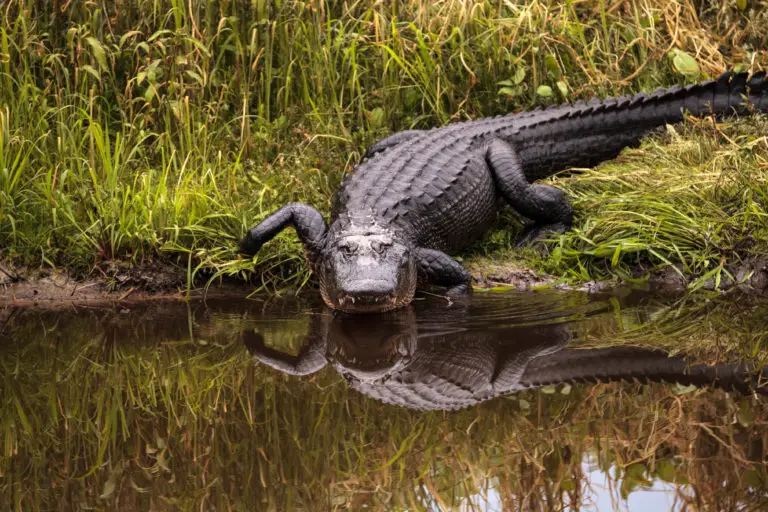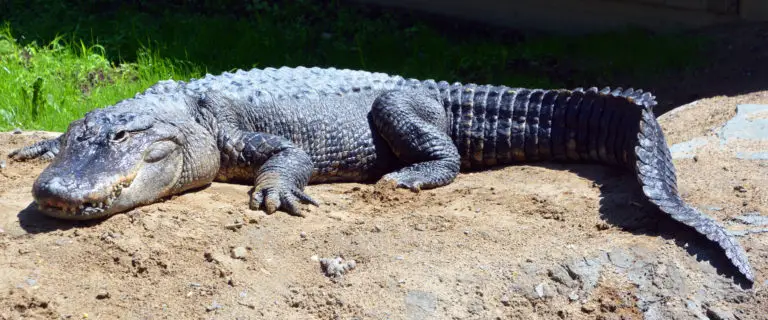In the wake of a grim discovery involving a human body found in the clutches of an alligator, law enforcement officials have refrained from confirming whether they suspect the reptile to be the perpetrator behind this tragic incident.
The specter of deadly alligator encounters is a phenomenon that seldom darkens our collective consciousness. As we delve into this unsettling episode, it’s important to shed light on the fact that such occurrences are exceedingly uncommon. A glance at statistics from AZ Animals, an authoritative online encyclopedia dedicated to the animal kingdom, reveals that on average, there are approximately six fatal alligator attacks documented in the United States annually. These sobering numbers underline the rarity of such incidents, making the current situation all the more perplexing and distressing.

Shocking Discovery: Alligator Found with Human Remains
In a chilling encounter on the afternoon of September 22, 2023, an Unincorporated Largo resident stumbled upon a truly unsettling scene during a casual stroll along 134th Avenue, near McKay Creek, just west of 121st Street. At approximately 1:45 p.m., an individual was confronted by a shocking sight: an alligator, seemingly grasping human remains within its menacing jaws.
In a bid to ward off the alligator, the resident resorted to throwing rocks at the reptile. What transpired next left him utterly astonished, as the alligator, still clinging to its gruesome discovery, swiftly retreated into the waters. Without delay, he rushed back to his nearby residence to alert his mother.
Together, they hurried to Largo Fire Station 39, determined to report the distressing encounter. Largo Firefighters, recognizing the gravity of the situation, promptly initiated contact with the Pinellas County Sheriff’s Office. Subsequently, the Florida Fish and Wildlife Conservation Commission (FWC) was alerted to the incident by the Sheriff’s Office. Swiftly responding to the distress call, the FWC dispatched an experienced alligator trapper to the scene to address this unsettling and macabre situation.
In an unfolding and harrowing incident, the efforts to recover an imposing 13-foot 8.5-inch alligator from the canal bank were met with formidable resistance. Consequently, the responding authorities were left with no choice but to resort to lethal measures, discharging their firearms twice to ensure the alligator’s containment. Subsequently, as the alligator was successfully removed from the canal, the Pinellas County Sheriff’s Office Dive Team undertook the challenging task of retrieving human remains submerged within the waters.
From the canal, law enforcement authorities retrieved the distressing discovery of an adult human torso, along with reports hinting at the potential presence of one or two additional limbs. This gruesome find has instigated a meticulous and comprehensive examination, which includes scrutinizing the contents of the alligator’s stomach, and commencing a thorough death investigation.
The victim has been identified as 41-year-old Sabrina Peckham, who was listed as a transient. The Medical Examiner’s Office is currently in the process of determining the manner and cause of her tragic demise. Additionally, the extent of the alligator’s involvement in this disturbing incident remains under scrutiny, with ongoing investigations.
It is worth noting that Sabrina Peckham had been arrested for trespassing on July 19, 2023, in connection with an incident on a posted county wetland property along the 12400 block of Ulmerton Road.
The road, which had been temporarily closed due to the incident, was reopened at approximately 5:30 p.m. once the initial response and recovery operations were concluded.
Any citizen concerned about an alligator should call FWC’s toll-free Nuisance Alligator Hotline at 866-392-4286.
How to Stay Safe If You See an Alligator
When encountering an alligator in the wild or near residential areas like the incident mentioned in the article, it’s crucial to prioritize safety for both yourself and the animal. Alligators are typically shy creatures, but they can be dangerous if provoked or feel threatened. Here are some additional tips on how to stay safe when you see an alligator:
- Maintain a Safe Distance: The first and most crucial step is to keep a significant distance from the alligator. Ensure you’re at least 20-30 feet away from it. Give the animal space and a clear escape route.
- Do Not Approach or Feed: Never attempt to approach or feed an alligator. Feeding them not only endangers you but also habituates the animal to human presence, which can lead to aggressive behavior.
- Keep Pets on a Leash: If you’re walking your dog near water bodies in alligator-prone areas, keep them on a leash. Alligators may see pets as potential prey, and keeping them close can help avoid confrontations.
- Stay Away from Water’s Edge: Avoid lingering near the water’s edge, especially during dawn and dusk when alligators are most active. They often bask in the sun near the shore, and surprising them can be dangerous.
- Back Away Slowly: If you inadvertently find yourself too close to an alligator, back away slowly and avoid sudden movements. Do not turn your back on the animal.
- Call Authorities: If you see an alligator in a residential area or behaving unusually, like the one in the article, it’s essential to call local authorities or wildlife control experts. They are trained to handle such situations safely.
- Familiarize Yourself with Local Regulations: Be aware of the regulations in your area regarding alligators. Some places may have specific guidelines for dealing with alligator encounters, and it’s important to follow them.
- Educate Yourself: Knowledge is your best defense. Learn about alligator behavior and habits to better understand how to coexist safely with them in their natural habitat.
Remember that alligators play a vital role in the ecosystem and are an essential part of the natural balance. By following these safety tips and respecting their space, you can help ensure a harmonious coexistence between humans and these magnificent reptiles.
Understanding Wildlife Behavior
Alligators are naturally inclined to prey upon small animals and occasionally, on larger mammals like deer or cattle. However, it is rare for them to attack humans. These reptiles play a crucial role in maintaining ecological balance within their habitats. Unfortunately, conflicts between humans and alligators do occur, especially when populations overlap in areas such as Florida, which is known for its wetlands and diverse wildlife.
To delve deeper into the fascinating world of alligator behavior, let’s unpack these key points one by one:
- Toothy Arsenal: Alligators are equipped with an impressive array of teeth, boasting about 80 of them. What’s even more remarkable is that they can grow new teeth to replace the old ones, and they can do this up to 50 times throughout their lives. This constant regeneration ensures that alligators always have sharp, functional teeth for their carnivorous lifestyle.
- Predatory Palette: Alligators are formidable carnivores. Their diet primarily consists of fish, turtles, birds, and various small animals. These apex predators use their stealth and immense power to ambush their prey, often lurking beneath the water’s surface and launching lightning-fast strikes to catch their unsuspecting victims.
- Seasonal Shifts: Like many cold-blooded creatures, alligators are most active during the warmer months. This heightened activity level is essential for their hunting and reproduction. As the temperature drops during colder months, alligators enter a state of reduced activity known as brumation, akin to hibernation in mammals. During this period, they conserve energy and can go without food for extended periods.
- Dimorphic Dimensions: One intriguing aspect of alligator biology is sexual dimorphism. Female alligators tend to be smaller in size compared to their male counterparts. Males typically reach lengths of 13-15 feet, while females are usually smaller, making them more agile and better adapted for certain tasks such as nest building and incubation.
The delicate balance between preserving wildlife and ensuring human safety is an intricate challenge. When dealing with creatures like alligators, authorities are faced with complex decisions that require careful consideration of multiple factors. The paramount concern is always the safety of the public, but it must be weighed against the importance of conserving these remarkable animals.
Approaching these situations with caution, expertise, and respect for both human life and wildlife is crucial. It involves creating and implementing effective management strategies that can protect both the public and the ecosystems where these creatures play essential roles. Conservation efforts often include measures such as controlled relocation, habitat preservation, and public education to raise awareness about living harmoniously with wildlife.

This Site Was Inspired By An Interest in Protecting the Environment:
We had the privilege and joy of learning from Dr. Charlie Stine who instilled a love for the natural world through incredible field trips with the Johns Hopkins Odyssey Certificate program in Environmental Studies. At the time, the program was endorsed by the Maryland Department of Natural Resources. Sadly, after Dr. Stine retired, the program was phased out. We hope that we honor his legacy by shining a bright light on environmental issues and sharing good news about the success of various conservation programs when possible.


